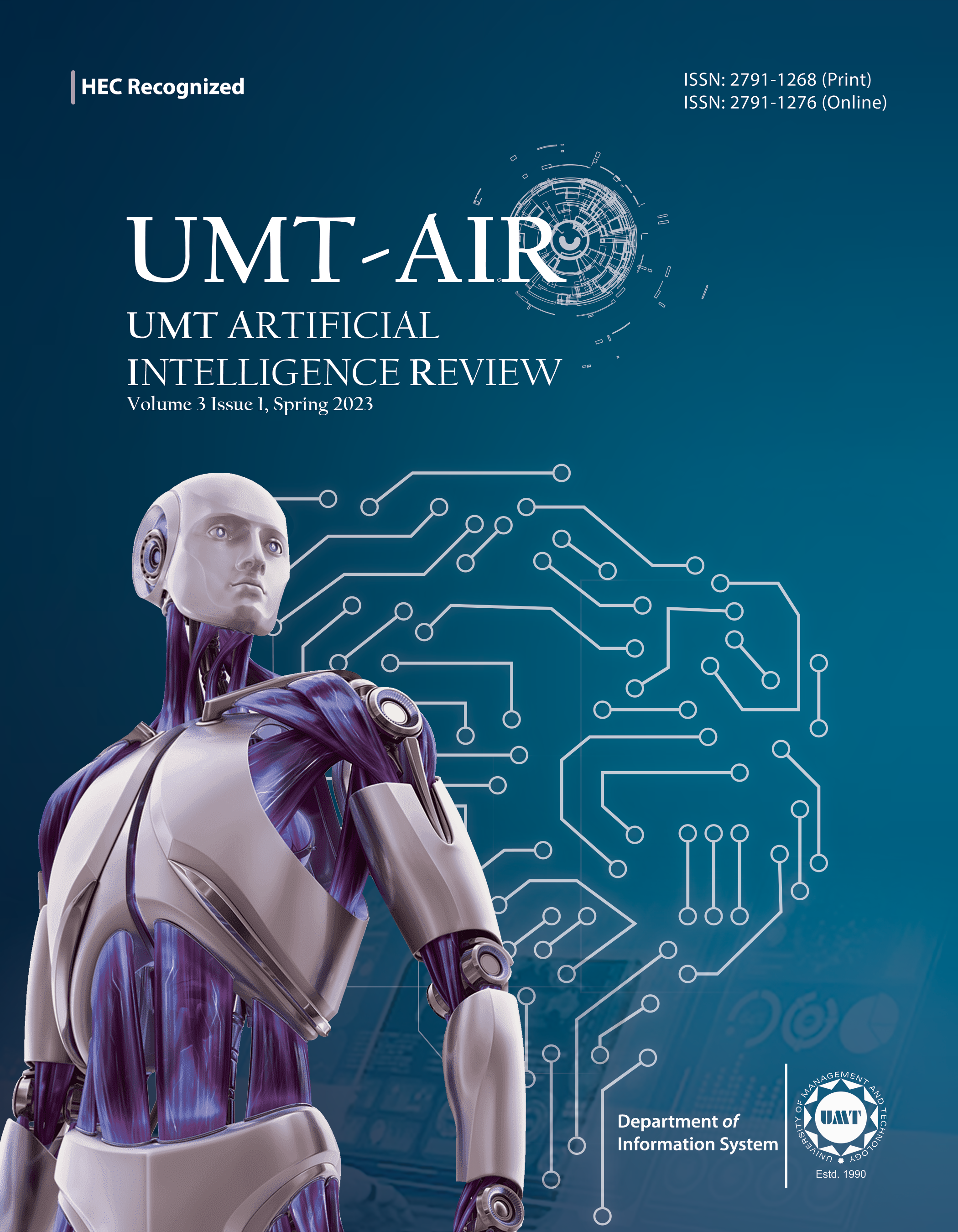A Machine Learning Framework for E. coli Bacteria Detection and Classification
Abstract
 Abstract Views: 0
Abstract Views: 0
Water plays an important role in physiological processes, such as the body's thermal equilibrium, the transfer of nutrients to the intended destination through the body, and the lubrication of joints. In Pakistan, the existing water availability is about 79%. Inadequate and adequate drinking water quality is a significant public health concern. In the project, we explain different machine learning techniques which are used to locate exact bacteria in a water sample, their shape, and scale. This technology promises sufficient identification and division. This invention allows for early identification of bacterial water pollution, requires minimal labor, etc. A robotic frame will speed up the treatment period without human power. It will reduce water emissions dramatically. The methods available for bacterial detection are effective but require lengthy waiting periods for results and expensive and laborious equipment. Via images with PYTHON (Its libraries), this research aims to detect bacteria utilizing images. This system tends to be effective and efficient way for water quality monitoring in different sectors in Pakistan. E.g., Wastewater treatment plants, Power plants, Industries, RO plants, and Laboratories.
Downloads
References
M. Daud, et al., “Drinking water quality status and contamination in Pakistan,” BioMed Res. Int., vol. 2017, Aug. 2017, Art. no. 7908183, doi: https://doi.org/10.1155/2017/7908183
F. Akova, et al., “A machine‐learning approach to detecting unknown bacterial serovars,” Stat. Anal. Data. Min., vol. 3, no. 5, pp. 289-301, Aug. 2010, doi: https://doi.org/10. 1002/sam.10085
H. Wang, et al., “Early detection and classification of live bacteria using time-lapse coherent imaging and deep learning,” Light Sci. Appl., vol. 9, no. 1, pp. 1-17, July 2020, doi: https:// doi.org/10.1038/s41377-020-00358-9
M. Poladia, P. Fakatkar, S. Hatture, S. Rathod, and S. Kuruwa, “Detection and analysis of waterborne bacterial colonies using image processing and smartphones,” in Int. Conf. Smart Technol. Manag. Comput. Commun. Control., Energy Materials, May 6-8, 2015, pp. 159-164, doi: https://doi. org/10.1109/ICSTM.2015.7225406
H. -w. Shi, Y. -w. Shi, and Y. -g. Yin, “Study on method of bacteria image recognition,” in 4th Int. Cong. Image Signal Proce., Oct. 15-17, 2011, pp. 273-277, doi: https://doi.org/10.1109 /CISP.2011.6099959
B. Zieliński, A. Plichta, K. Misztal, P. Spurek, M. Brzychczy-Włoch, and Ochońska, “Deep learning approach to bacterial colony classification,” PloS one, vol. 12, no. 9, Sep. 2017, Art. no. 0184554, doi: https://doi.org/10. 1371/journal.pone.0184554
J. Brownlee, “How to configure image data augmentation in Keras,” Machine Learning Mastery. https:// machinelearningmastery.com/how-to-configure-image-data-augmentation-when-training-deep-learning-neural-networks/ (accessed Mar. 30, 2021).
E. P., “What is image acquisition in image processing?,”Easy Tech Junkie. https://www.infobloom.com/what-is-image-acquisition-in-image-processing.htm (accessed Mar. 29, 2021).
W. Ahmed, B. Bayraktar, A. Bhunia, E. Hirleman, J. Robinson, and B. Rajwa, “Classification of bacterial contamination using image processing and distributed computing,” IEEE J. Biomed. Health Inform., vol. 17, no. 1, pp. 232-239, Oct. 2012, doi: https:// doi.org/10.1109/TITB.2012.2222654
K. Horak, J. Klecka, and M. Richter, “Water quality assessment by image processing,” in 38th Int. Conf. Telecommun. Signal Process, 2015, pp. 577-581, doi: https://doi.org /10.1109/TSP.2015.7296329
P. Sharma, “Computer vision tutorial: A step-by-step introduction to image segmentation techniques (Part 1),” https://www.analyticsvidhya.com/blog/2019/04/introduction-image-segmentation-techniques-python/ (accessed March 30, 2021).
J. Salzman, “Thirst: A short history of drinking water,” Yale JL & Human, vol. 18, 2005.
S. C. Edberg, E. W. Rice, R. J. Karlin, and M. J. Allen, “Escherichia coli: the best biological drinking water indicator for public health protection,” J. Appl. Microbiol., vol. 88, no. S1, pp. 106S-116S, Nov. 2000, doi: https://doi.org/10.1111/j.1365-2672. 2000.tb05338.x
N. Rosemann, “Drinking-Water crisis in Pakistan and the issue of bottled Water: The case of Nestlé’s ‘Pure Life,” Actionaid Pakistan, pp. 1-37, Apr. 2005. https://www.humanrights. ch/cms/upload/pdf/050829_drinkingwaterpakistan_rosemann2005.pdf
M. F. Chaplin, “Water: its importance to life,” Biochemistry and molecular biology education, vol. 29, no. 2, pp. 54-59, Mar. 2001, doi: https://doi.org/ 10.1016/S1470-8175(01)00017-0
S. Felson, “What is E. Coli?,” WebMD. https://www.webmd.com /food-recipes/food-poisoning/what-is-e-coli (accessed Mar. 29, 2021).
D. Zelman, "What is salmonella?" WebMD. https://www.webmd.com /food-recipes/food-poisoning/what-is-salmonella (accessed Mar. 29, 2021).
lenntech, "History of drinking water treatment,”. https://www.lenntech.com /processes/disinfection/history/history-drinking-water-treatment.htm (accessed Mar. 29, 2021).
L. Huang and T. Wu, “Novel neural network application for bacterial colony classification,” Theor. Biol. Med. Model., vol. 15, no. 1, pp. 1–16, Dec. 2018, doi: https://doi.org/10. 1186/s12976-018-0093-x
Copyright (c) 2023 Bushra Naz, Shahzad Hyder, Azlan Ahmed, Ali Hasnain

This work is licensed under a Creative Commons Attribution 4.0 International License.
UMT-AIR follow an open-access publishing policy and full text of all published articles is available free, immediately upon publication of an issue. The journal’s contents are published and distributed under the terms of the Creative Commons Attribution 4.0 International (CC-BY 4.0) license. Thus, the work submitted to the journal implies that it is original, unpublished work of the authors (neither published previously nor accepted/under consideration for publication elsewhere). On acceptance of a manuscript for publication, a corresponding author on the behalf of all co-authors of the manuscript will sign and submit a completed the Copyright and Author Consent Form.







